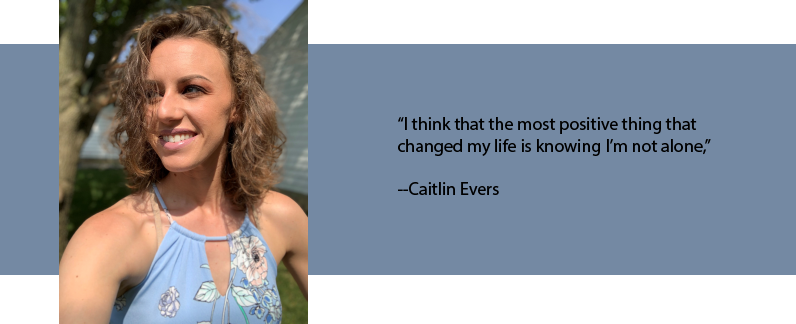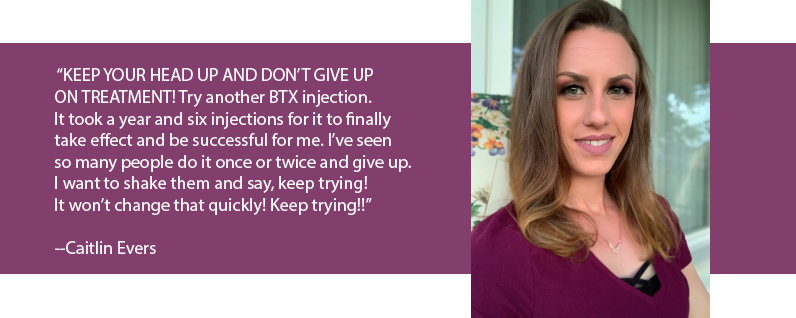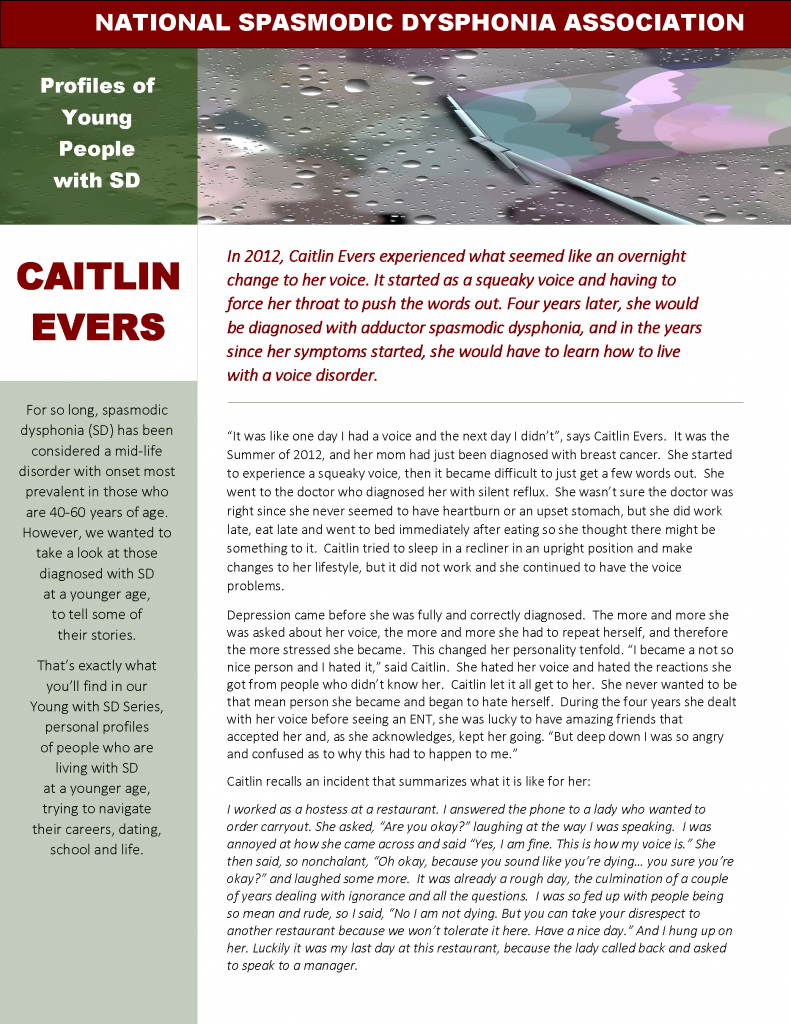In 2012, Caitlin Evers experienced what seemed like an overnight change to her voice. It started as a squeaky voice and having to force her throat to push the words out. Four years later, she would be diagnosed with adductor spasmodic dysphonia, and in the years since her symptoms started, she would have to learn how to live with a voice disorder.
One day I had a voice, the next I didn’t
“It was like one day I had a voice and the next day I didn’t”, says Caitlin Evers. It was the Summer of 2012, and her mom had just been diagnosed with breast cancer. She started to experience a squeaky voice, then it became difficult to just get a few words out. She went to the doctor who diagnosed her with silent reflux. She wasn’t sure the doctor was right since she never seemed to have heartburn or an upset stomach, but she did work late, eat late and went to bed immediately after eating so she thought there might be something to it. Caitlin tried to sleep in a recliner in an upright position and make changes to her lifestyle, but it did not work and she continued to have the voice problems.

Depression set in
Depression came before she was fully and correctly diagnosed. The more and more she was asked about her voice, the more and more she had to repeat herself, and therefore the more stressed she became. This changed her personality tenfold. “I became a not so nice person and I hated it,” said Caitlin. She hated her voice and hated the reactions she got from people who didn’t know her. Caitlin let it all get to her. She never wanted to be that mean person she became and began to hate herself. During the four years she dealt with her voice before seeing an ENT, she was lucky to have amazing friends that accepted her and, as she acknowledges, kept her going. “But deep down I was so angry and confused as to why this had to happen to me.”
Caitlin recalls an incident that summarizes what it is like for her: I worked as a hostess at a restaurant. I answered the phone to a lady who wanted to order carryout. She asked, “Are you okay?” laughing at the way I was speaking. I was annoyed at how she came across and said “Yes, I am fine. This is how my voice is.” She then said, so nonchalant, “Oh okay, because you sound like you’re dying… you sure you’re okay?” and laughed some more. It was already a rough day, the culmination of a couple of years dealing with ignorance and all the questions. I was so fed up with people being so mean and rude, so I said, “No I am not dying. But you can take your disrespect to another restaurant because we won’t tolerate it here. Have a nice day.” And I hung up on her. Luckily it was my last day at this restaurant, because the lady called back and asked to speak to a manager.
The manager spoke to the lady, took her order and came up to talk to me. He knew how sensitive I was about people asking about my voice because I’d come to him crying because of the rudeness of customers. He had a smile on his face, and said “granted it is your last day and if it wasn’t I would have had to suspend you, but…the fact that she said THAT to you, and you said THAT to her, actually made my day!” So I did not get in trouble, and the best part was that the lady didn’t know who to give her dirty look to when she came in to pick up her food. It was pretty gratifying to know that my disorder isn’t shown on my skin, but sometimes I wish it was..“
Caitlin makes a big life decision that changes everything
Caitlin lived over two hours away from her family, so along with feeling depressed, stressed out, isolated, and angry, she also felt hopeless for her mom. She was scared to death of her mother being sick and that impacted her level of psychological strength, making it all worse. So in 2016, Caitlin decided to move back home. She started a new job at Ferguson Enterprises in Celina, OH, where she is the DC Administrative Associate of the Pipeyard.
When she moved back home she was terrified to meet new people. It was strange to meet up with friends she hadn’t seen since high school and reconnect again. But dating was an eyeopening experience that hurt so much. She would communicate through a chat site and then the guy would want to have a voice call. “I never had the guts to do it” she admits. Once they chatted for a few weeks, they would make a date to meet and the date would go well. They would plan a second date, then the guy would ghost her. “And I swear this happened 6 times in 4 months” she says. This made her feel lonely, depressed, unworthy, and almost ashamed of who she was. She wondered, “what’s wrong with me or is my “stupid” voice disorder scaring them all away?”
Then she started seeing a new family doctor, Dr. Megan Core, at Coldwater Medical in Coldwater, OH. She knew right away it was a voice disorder as soon as she heard Caitlin talking.
Dr. Core then referred her to see an ENT specialist in Dayton at The Blaine Block Institute for Voice Analysis. It was Dr. Wendy LeBorgne who diagnosed her as having adductor spasmodic dysphonia.
About SD
Spasmodic dysphonia (SD) is a task-specific, focal dystonia; meaning that the muscles spasm only when they are used for particular actions and not when they are at rest. When a person with SD attempts to speak, involuntary spasms in the tiny muscles of the larynx cause the voice to break up or sound strained, tight, strangled, breathy, or whispery. With the adductor form, the spasms often interrupt the sound, squeezing the voice to nothing in the middle of a sentence. SD is a neurological disorder but it does not impact a person’s cognitive capabilities and it does not affect life expectancy.
She tries BTX
Dr. LaBorgne suggested she try BTX injections. “I felt so wonderful to finally have a correct diagnosis, and with the BTX, a voice I didn’t have to force out. I could speak paragraphs of stories instead of taking a deep breath just to get out a few words,” said Caitlin. “My family was probably more excited than I was when I finally had a voice! Especially when they heard me speak that first time. The love and hugs I received were refreshing.”

Caitlin’s new job
At work, she does the logistics for the drivers coming in to pick up orders for the pipe being shipped out. She needs to be able to communicate with drivers, other Ferguson branches, and truck carriers to schedule pickups. She’s constantly on a computer, but she does talk on the phone and in person with co-workers and drivers. Talking on the phone is easy, especially after she gets an injection. It’s the last month before the next injection that is usually the most difficult, but not as bad as it could be without the BTX.
When she interviewed for this job, they asked if she had any personal issues that could affect her getting the position, of course she said no, but she did mention her voice. She knew it wouldn’t affect her work ethic, but disclosed it anyway. She got a promotion in May 2018, and says “I definitely worked my hardest to get where I am right now.”
In addition to working at Ferguson, she is a licensed cosmetologist. Before moving home and getting BTX, coming into the salon was stressful. She lost a lot of clients because they thought she was sick and they didn’t want a “sick” person to be touching their hair or face. Now she works part time doing hair and it has become so much easier. She is building a clientele and since she lives in her hometown everyone knows about her SD.
What adjustments did she make due to her SD?
When asked what she needed to adjust in order to live a life with SD, Caitlin admits, “mostly my attitude. I had a lot going on in my head while I was seeing my ENT specialist, wishing and hoping for relief with BTX injections, and trying to maintain a social life. Work was stressing me out, dating was stressing me out, living with my parents again (ugh…), and just trying to deal with the constant ‘why me?’.
But as time went on, I changed my attitude at work, I got my own apartment, started dating, and my life started to fall into place. My life is nowhere near perfect by any means, but it is pretty close. So while moving back home was a huge decision for me, it was also the best decision I could have ever made,” said Caitlin.
She realizes she’s not alone
She had never heard anyone else with the same voice, didn’t know much about the NSDA and never went to a support group meeting. However, she found the Young SD-er’s Facebook Group. Knowing that other people have this same disorder was a HUGE relief, but then she realized she had to hold her altruism at bay because she was getting excellent results from BTX and others weren’t. She doesn’t want to be too open about her success and is careful not to be too boastful about it. She’s made new friends through the Facebook groups and hopes to meet them someday. “I think that the most positive thing that changed my life is knowing I’m not alone,” said Caitlin.
Her advice to others with SD
When asked what advice she would give others with SD, she says: “KEEP YOUR HEAD UP AND DON’T GIVE UP ON TREATMENT! Try another BTX injection. It took a year and six injections for it to finally take effect and be successful for me. I’ve seen so many people do it once or twice and give up. I want to shake them and say, keep trying! It won’t change that quickly! Keep trying!!” And as for the future, Caitlin says, “I think my view of where I would be in 10 years is the same basic cliché idea every 20-something has…married, kids, happy, successful.”



